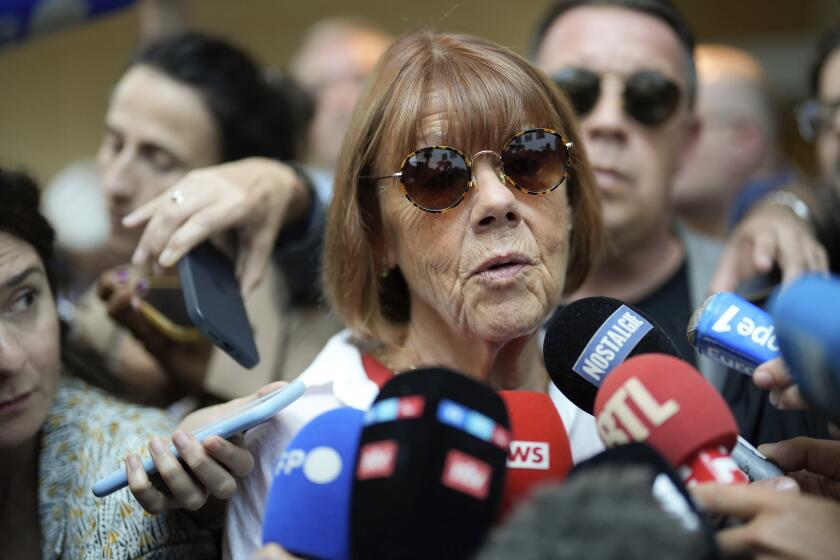Documentary reignites controversy over Michael Brown’s actions before Ferguson shooting

New surveillance footage from a Ferguson, Missouri, convenience store shows Michael Brown about 10 hours before he was shot by police.
Reporting from Clayton, Mo. — St. Louis County prosecutor Robert McCulloch was critical Monday of store surveillance footage from a new documentary about the Michael Brown shooting in Ferguson, Mo., calling it a heavily edited attempt to distort an incident that occurred several hours before Brown died in an encounter with a police officer.
McCulloch dismissed the “Stranger Fruit” documentary footage during a news conference and released five surveillance videos from the early hours of Aug. 9, 2014, at Ferguson Market and Liquor. He said the unedited videos told a different story than the filmmakers suggested.
The footage in the documentary “was clearly an attempt to distort this and turn it into something it isn’t,” McCulloch said.
And he added that it was potentially dangerous, setting off a Sunday night protest of about 100 people that included reports of shots fired and the arrest of a man accused of trying to blow up a police car by putting a napkin in the gas tank and trying to light it. Henry Stokes, 44, was charged Monday with attempting to cause a catastrophe.
An email message left with filmmaker Jason Pollock was not immediately returned.
Brown, 18, who was black and unarmed, was fatally shot shortly after noon on Aug. 9, 2014, during a violent encounter with white Officer Darren Wilson. Wilson was eventually cleared of wrongdoing by both a St. Louis County grand jury and the U.S. Department of Justice, but the shooting set off months of sometimes violent protests.
Within days of Brown’s death, Ferguson police released surveillance video from Ferguson Market purporting to show Brown stealing cigarillos from the store shortly before noon. He left the store and was walking on Canfield Drive when Wilson told him to get on the sidewalk and off the street — the beginning of their fatal confrontation.
The documentary, which premiered Saturday at the South by Southwest festival in Austin, Texas, includes earlier and previously unseen surveillance footage from inside the store.
The footage, which has no audio, shows Brown inside the store at 1:14 a.m. getting what appears to be two drinks from a cooler, then going to the counter and requesting cigarillos. The clerk puts the drinks and cigarillos in a bag. Brown gives something to a clerk, who appears to sniff it. Brown starts to leave but then returns to the counter, talks to the clerks and leaves without the bag.
Pollock told the New York Times he believes the footage shows Brown trading a small amount of marijuana in exchange for the cigarillos. Pollock reasons Brown returned 10 hours later to pick up the bag of cigarillos that he simply had set aside earlier.
It’s an important distinction because the police have always claimed that Brown stole the cigarillos. And days after Brown was killed, they released surveillance video that showed Brown grabbing cigarillos, pushing aside a worker who tried to stop him and walking out of the store.
Both McCulloch and Jay Kanzler, an attorney for Ferguson Market, said there was no bartered deal between Brown and the market workers.
“It’s very clear there was no transaction between Mr. Brown and the store employees,” McCulloch said. “And the suggestion that he’s coming back to pick up what he bartered for is just stupid.”
The grainy unedited footage, which Kanzler also released, shows a clerk pulling both boxes of cigarillos from the bag after Brown leaves and putting them back on a shelf. Another worker takes the drinks back toward the cooler.
The newly released footage also raised questions about how forthcoming police and prosecutors were about evidence in the case. McCulloch said the earlier encounter involving Brown at the store was noted in a police report released on the night in November 2014 when a St. Louis County grand jury decided not to indict Wilson.
The prosecutor said that video was never released because the incident did not result in any charges and the footage was “immaterial” to what happened later that day.
Still, the St. Louis County chapter of the NAACP said it was “deeply concerned” about the footage that’s just now surfacing.
“Regardless of what was revealed in the video, Michael Brown should have never lost his life,” board member John Gaskin III said in a statement. “If the (documentary) video is accurate and valid, it is unfortunate that Brown was portrayed internationally as a ‘thief’ and ‘criminal.’ It remains injudicious that so many men of color are racially profiled on an ongoing basis and far too frequently guilty until proven innocent in the United States’ criminal justice system.”
ALSO
When are police justified in using deadly force?
Three black men talk about Rodney King, 25 years later
UPDATES:
3:25 p.m.: The story was updated with new information from prosecutor Robert McCulloch, who released new surveillance videos during a news conference Monday.
8:25 a.m.: The story was updated to include attorney Jay Kanzler’s intention to release an unedited version of the surveillance video, as well as details about the protests that occurred Sunday night.
The story was originally published at 6:55 a.m.
More to Read
Sign up for Essential California
The most important California stories and recommendations in your inbox every morning.
You may occasionally receive promotional content from the Los Angeles Times.










